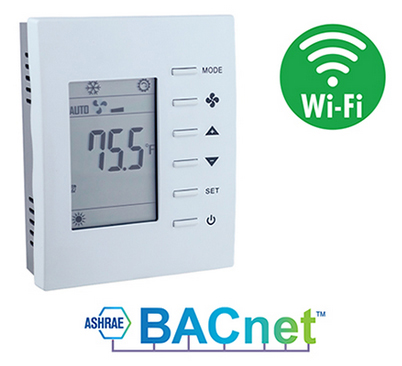Control Network Newsletter

BASstat Configuration Advice to Maximize Operation
 The BASstat BACnet-compliant wired or wireless communicating thermostats provide turnkey integration into BACnet/IP (Wi-Fi) or BACnet MS/TP (EIA-485) networks. The advice below facilitates product configuration and maximizes operation.
The BASstat BACnet-compliant wired or wireless communicating thermostats provide turnkey integration into BACnet/IP (Wi-Fi) or BACnet MS/TP (EIA-485) networks. The advice below facilitates product configuration and maximizes operation.
Configuring Temperature Setpoints
The BASstat has four configurable temperature setpoints: Occupied Heat, Occupied Cool, Unoccupied Heat, and Unoccupied Cool. Only the currently active setpoint is displayed on the BASstat LCD panel during normal operation. This active setpoint can be adjusted directly by pressing the UP/DOWN buttons on the control panel.
However, the inactive Occupied Heat or Occupied Cool setpoint cannot be adjusted from the BASstat control panel. The inactive Occupied mode must be activated using the MODE button, then it can be adjusted using the UP/DOWN buttons on the control panel. For example, if the BASstat is in Occupied Heating mode, the Occupied Heating temperature setpoint can be adjusted on the control panel; but the Occupied Cooling mode cannot be viewed or set until the BASstat operating MODE is changed over to Occupied Cooling.
The Unoccupied Cooling setpoint (ESIC) and Unoccupied Heating setpoint (ESIH) can be read and adjusted at the control panel via the Engineering Menu at any time. All setpoints can also be set directly from the BACnet supervisor controller or from the BACnet Discovery Tool (BDT) to the BASstat at any time it is reachable on the network, irrespective of the operating mode.
Calibrating the BASstat
The BASstat's internal temperature measuring thermistor maintains an accuracy of +/- 1.8°F (+/- 1.0°C). If any temperature offset adjustments are necessary, it is best practice to wait at least 30 minutes after powering up the BASstat before making any adjustments from either BACnet point AV15 or the OFSt command from the Engineering Menu.
Working with the Heartbeat
In order for the BASstat to accept remote BACnet temperature and setpoint data input from a Building Management System (BMS), the BASstat must receive a timed pulse (heartbeat) from the BMS supervisor "head-end" during an established time interval. This minimum interval (Heartbeat Rate) is set at BACnet point AV29. This pulse (a data "1") needs to be received at BACnet point BV16 during this interval for the BASstat to maintain communication of the head-end's control output data (occupancy, setpoints, temperature data, etc.) If a new heartbeat pulse is not received before the last one times out, the BASstat will assume that the head-end supervisor is offline and use only locally measured data. This AV29 interval can be set to any rate between 10 to 3600 seconds (default setting is 10s). It is best practice to have the head-end send out this pulse to BV16 at a rate 2x-3x the AV29 interval. For example, if the AV29 interval is set to 240 seconds, it would be a good idea to send out the BV16 pulse between 90-120 seconds. This can compensate for possible delayed or missed network communication. This is especially important when working with BACnet/IP over Wi-Fi.
Next month, we'll publish more BASstat setup and operating tips. Until then, learn more about the BASstat by visiting the BASstat Series product page.